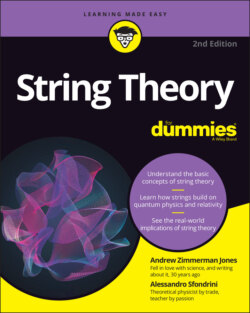Читать книгу String Theory For Dummies - Andrew Zimmerman Jones - Страница 78
Old becomes new again: Science as revolution
ОглавлениеThe interplay between experiment and theory is never so obvious as in those realms where they fail to match up. At that point, unless the experiment contained a flaw, scientists have no choice but to adapt the existing theory to fit the new evidence. The old theory must transform into a new theory. The philosopher of science Thomas Kuhn spoke of such transformations as scientific revolutions.
In Kuhn’s model (which not all scientists agree with), science progresses along until it accumulates a number of experimental problems that make scientists redefine the theories that science operates under. These overarching theories are scientific paradigms, and the transition from one paradigm to a new one is a period of upheaval in science. In this view, string theory would be a new scientific paradigm, and physicists would be in the middle of the scientific revolution where it gains dominance.
A scientific paradigm, as proposed by Kuhn in his 1962 work, The Structure of Scientific Revolutions, is a period of business as usual for science. A theory explains how nature works, and scientists work within this framework.
Kuhn viewed the Baconian scientific method — regular puzzle-solving activities — as taking place within an existing scientific paradigm. The scientist gains facts and uses the rules of the scientific paradigm to explain them.
The problem is that there always seems to be a handful of facts that the scientific paradigm can’t explain. A few pieces of data don’t seem to fit. During the periods of normal science, scientists do their best to explain this data, to incorporate it into the existing framework, but they aren’t overly concerned about these occasional anomalies.
That’s fine when there are only a few such anomalies, but when enough of them pile up, it can pose serious problems for the prevailing theory.
As these abnormalities begin to accumulate, the activity of normal science becomes disrupted and eventually reaches the point where a full scientific revolution takes place. In a scientific revolution, the current scientific paradigm is replaced by a new one that offers a different conceptual model of how nature functions.
At some point, scientists can’t just proceed with business as usual anymore, and they’re forced to look for new ways to interpret the data. Initially, scientists attempt to do that with minor modifications to the existing theory. They can tack on an exception here or a special case there. But if there are enough anomalies, and if these makeshift fixes don’t resolve all the problems, scientists are forced to build a new theoretical framework.
In other words, during a scientific revolution, scientists are forced not only to amend their theory, but to construct an entirely new paradigm. It isn’t just that some factual details were wrong, but that their most basic assumptions were wrong. In a period of scientific revolution, scientists begin to question everything they thought they knew about nature. For example, in Chapter 10 you see that string theorists have been forced to question the number of dimensions in the universe.
